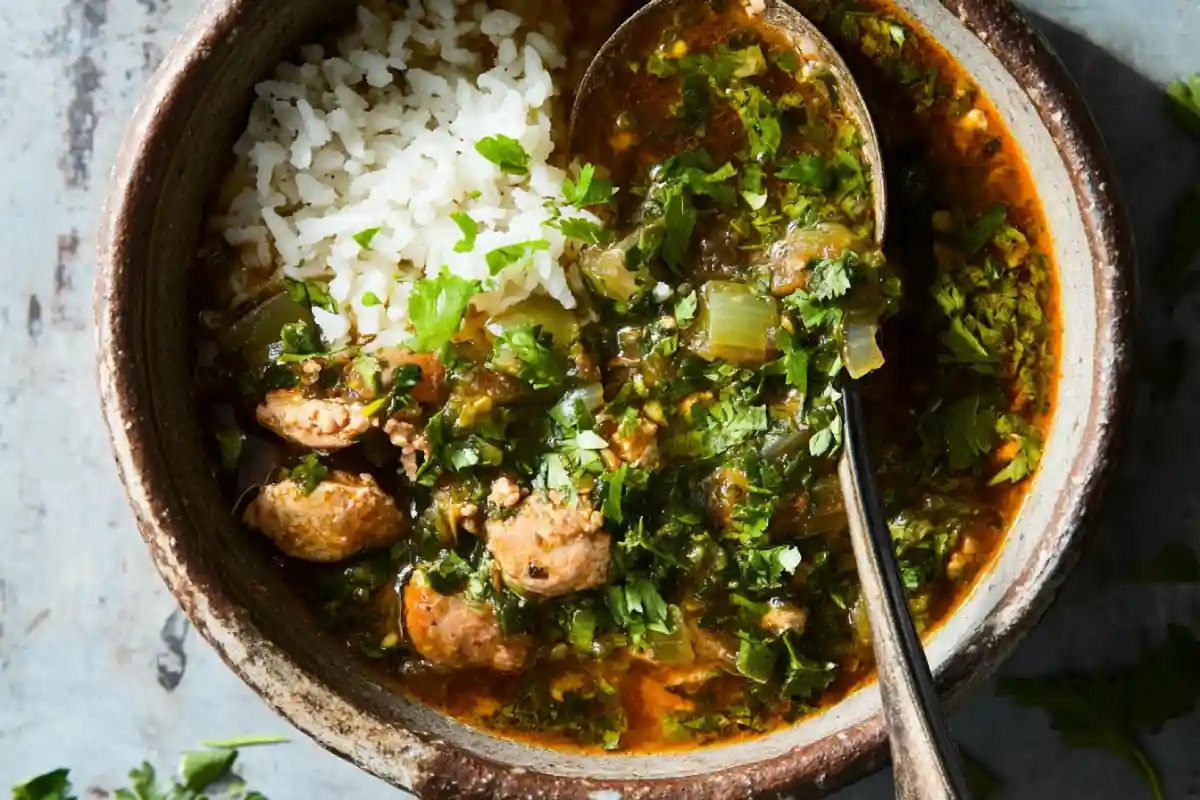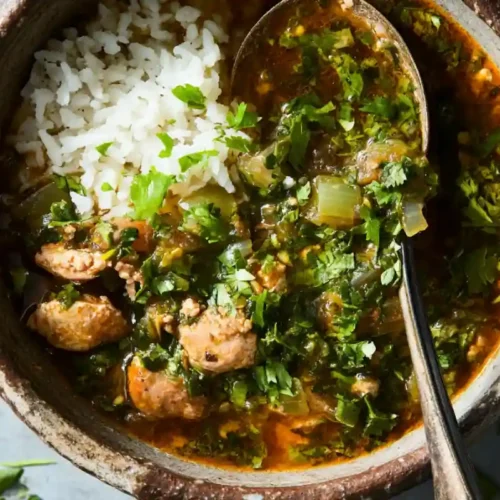
Table of Contents
This all-star gumbo recipe marries a bittersweet-chocolate roux, juicy bone-in chicken, beef-turkey andouille, and late-add shrimp for a true surf-and-turf bowl. After five side-by-side tests I locked a 40-minute simmer: it melts the trinity veggies, keeps rice fluffy, and perfumes the kitchen with unmistakable Cajun spice.
What Is Gumbo?
Grasping the foundation of a great gumbo recipe begins with understanding what gumbo truly is. At its essence, gumbo is a rich, hearty creation that lies somewhere between a soup and a stew. Traditionally, it is made with a flavorful stock, a roux base, and a variety of proteins like chicken, sausage, or seafood. What makes a gumbo recipe so special, however, is the powerful layering of flavors that develop slowly as the dish simmers.
Moreover, gumbo highlights the beauty of regional cuisines. It developed in Louisiana, showcasing a vibrant fusion of African, French, Spanish, and Native American influences. As a result, no two gumbos are ever quite the same. Some variations are thickened with okra, while others use filé powder, a seasoning derived from ground sassafras leaves. To dive deeper into the cultural significance of gumbo, you can explore an insightful guide from Smithsonian Magazine which highlights gumbo’s remarkable journey through American history.
In addition to traditional ingredients, many cooks today simplify the process by using pre-made gumbo bases. While this shortcut can save time, creating your own roux from scratch is an experience worth trying. For example, a dark, caramel-colored roux adds an unmatched depth that no packaged product can truly replicate. To understand the art of making a proper roux, you might find this helpful resource from Serious Eats valuable, as it explains step-by-step how to achieve the perfect texture and color.
Here are the essential elements every gumbo recipe must include:
- A flavorful roux (oil or butter mixed with flour)
- The “holy trinity” (onions, celery, bell peppers)
- Rich stock (chicken, seafood, or beef)
- Proteins (chicken, andouille chicken sausage, shrimp, crab)
- Seasonings (Cajun spices, bay leaves, thyme)
- Thickeners (okra or filé powder)
For more inspiration on Louisiana’s culinary landscape and to discover other traditional recipes, you might also enjoy exploring Louisiana Dishes Recipes.
Thus, a gumbo recipe is not just about cooking; it’s about preserving a rich culinary tradition, celebrating bold flavors, and embracing creativity at every turn.
Essential Ingredients in a Gumbo Recipe
Every great gumbo recipe begins with a strong foundation of carefully selected ingredients. Although variations exist depending on family traditions or regional styles, certain components remain constant. By understanding these essential elements, you can create a dish that is both authentic and bursting with flavor.
First and foremost, every gumbo recipe needs a proper roux. A roux is a mixture of fat and flour cooked together to create a rich, nutty base that thickens and flavors the dish. A dark brown roux is typically preferred for gumbo because it adds a deep, almost smoky character. Without this step, achieving that signature depth would be nearly impossible.
Next, you must include the holy trinity of vegetables, which consists of:
- Onions
- Celery
- Bell peppers
These vegetables form the aromatic backbone of every classic gumbo recipe. Notably, the combination of these three simple ingredients builds a complex flavor profile as they cook down into the roux.
Moreover, no gumbo would be complete without high-quality proteins. Traditional options include:
- Chicken (commonly in a hearty chicken gumbo)
- Andouille chicken sausage (for its spicy, smoky flavor)
- Seafood such as shrimp, crab, or crawfish
Additionally, seasonings play a critical role. Using authentic Louisiana spices, including Cajun seasoning and fresh herbs like thyme and bay leaves, ensures your gumbo recipe sings with bold Southern flavors.
For thickening, you have two traditional options: okra and filé powder (ground sassafras leaves). Both add unique textures and flavors. Interestingly, the inclusion of okra reflects African culinary traditions, while filé powder has Native American roots.
If you’re looking for new ways to explore Cajun cooking, consider checking out Cajun Seasoning for Gumbo for homemade seasoning tips that pair perfectly with your next gumbo recipe.
By mastering these essential ingredients, you lay the groundwork for a truly memorable gumbo recipe — one that is rich, flavorful, and deeply satisfying.
How to Make Gumbo: Step-by-Step Guide
Crafting a perfect gumbo recipe may seem intimidating at first, but with the right steps, anyone can master this hearty dish. Fortunately, the process is straightforward once you understand the basics. Moreover, taking your time at each stage ensures a flavorful result that will impress every guest.
Step 1: Making the Roux
First and most importantly, a good roux sets the tone for the entire gumbo recipe. You’ll need equal parts fat (such as oil or butter) and flour. Cook them slowly over medium heat, stirring constantly. Patience is essential here. The roux should darken gradually, reaching a deep brown color without burning.
Key Tips:
- Use a heavy-bottomed pan to prevent scorching.
- Stir continuously to achieve even coloring.
- Aim for a rich, chocolate-brown hue.
| Ingredient | Quantity |
|---|---|
| Flour | ½ cup |
| Oil/Butter | ½ cup |
Step 2: Cooking the Holy Trinity
Once your roux is ready, immediately add the chopped vegetables:
- Onions
- Celery
- Bell peppers
Stir them into the roux to release their aromas and deepen the flavor. This combination forms the savory heart of any gumbo recipe.
Step 3: Layering Flavors
After the vegetables have softened, gradually add your stock. This not only loosens the roux but also starts building the soup’s rich body. Next, incorporate seasonings such as:
- Bay leaves
- Cajun seasoning
- Thyme
Additionally, if you enjoy bold flavors, you can sprinkle in a bit of hot sauce. Every addition should be stirred well to create a harmonious blend.
Step 4: Simmering and Final Additions
Once everything is combined, it’s time to simmer. Allow the gumbo to cook gently, typically for about 45 minutes to one hour. In the final 15 minutes, add your proteins:
- Chicken
- Andouille chicken sausage
- Shrimp or crab (added at the very end to avoid overcooking)
As a final touch, sprinkle in some filé powder to thicken and flavor the dish. Be careful not to boil after adding filé, as it can become stringy.
If you are looking for other classic Louisiana seafood ideas to complement your gumbo, take a look at this Creole Seafood Jambalaya for inspiration.
By following these simple but crucial steps, your gumbo recipe will have the rich, complex layers of flavor that true Louisiana gumbo is known for. After mastering these techniques, creating variations — like a chicken and sausage gumbo or a seafood gumbo — becomes second nature.
Variations of Gumbo
Although a traditional gumbo recipe shares a common foundation, several mouthwatering variations have developed across Louisiana. Understanding the subtle but important differences between each style allows you to customize your gumbo perfectly. Moreover, experimenting with these styles ensures that your culinary skills continue to evolve.
Cajun Gumbo Recipe
Cajun gumbo is hearty and richly flavored, typically made without tomatoes. This style focuses on a dark roux and hearty meats like chicken and andouille chicken sausage. Because the emphasis is on smoky richness, seafood is used sparingly if at all.
Key Features of Cajun Gumbo:
- No tomatoes
- Dark, deeply colored roux
- Meat-heavy (especially sausage and chicken)
| Ingredient | Common in Cajun Gumbo? |
|---|---|
| Tomatoes | Rare |
| Chicken | Often |
| Andouille chicken Sausage | Always |
| Seafood | Occasionally |
For additional ideas on enhancing your Cajun cooking, you may enjoy this Cajun Food Overview, which highlights other classic recipes you might want to try alongside your gumbo recipe.
Creole Gumbo
In contrast, Creole gumbo includes tomatoes and often leans more toward seafood. This version reflects the French and Spanish culinary influences prominent in New Orleans.
Key Features of Creole Gumbo:
- Tomatoes included in the base
- Seafood-rich (shrimp, crab, oysters)
- Lighter roux compared to Cajun versions
Importantly, Creole gumbo often tastes a bit fresher and slightly sweeter due to the tomatoes. If you ever wondered, does gumbo have tomatoes? — the answer depends on whether you are making a Creole or a Cajun version!
Black Gumbo
Black gumbo, often referred to in rural Louisiana, takes its name from the extremely dark roux and deep, earthy flavors. Because it can appear almost black in color, it’s a style favored for its intense smokiness and hearty feel.
Black Gumbo Highlights:
- Extremely dark roux
- Minimal vegetables
- Strong, smoky taste
Christmas Gumbo Recipe
Lastly, Christmas gumbo is a festive tradition. During the holidays, families often use whatever seafood and meat are available to create a rich, celebratory dish. Consequently, no two Christmas gumbo recipes are alike, yet they all share a focus on abundance and celebration.
Christmas Gumbo Features:
- Mixed proteins (turkey, chicken ham, shrimp, oysters)
- Seasonal vegetables
- Festive spices added for warmth
For more holiday inspiration, you can check out Best Mardi Gras Food which provides ideas perfect for festive tables alongside a warm, hearty gumbo recipe.
By understanding these different variations, you can easily customize your next gumbo recipe to suit any occasion, whether you prefer a rustic Cajun style, a bright Creole version, or a rich holiday special.
Frequently Asked Questions About Gumbo Recipe
When diving into a traditional gumbo recipe, many cooks—whether beginners or seasoned chefs—have common questions. Understanding these key points ensures you can create a gumbo that is both delicious and authentic. Moreover, by mastering these basics, you’ll feel confident experimenting with different styles and ingredients.
What are the ingredients in gumbo?
A classic gumbo recipe includes a roux, stock, the holy trinity of onions, celery, and bell peppers, proteins like chicken, sausage, or seafood, Cajun or Creole seasonings, and a thickener such as okra or filé powder.
What are the 2 rules of gumbo?
The two main rules are: never burn the roux, as it will create a bitter taste, and always allow the gumbo to simmer slowly to develop deep, rich flavors.
What are the three types of gumbo?
The three main types of gumbo are seafood gumbo, chicken and sausage gumbo, and okra gumbo, each offering a different texture and flavor profile depending on the main ingredients used.
Should gumbo be thick or soupy?
Gumbo should have a thick, hearty consistency that coats a spoon without being overly heavy. However, the thickness can vary depending on the specific gumbo recipe and whether okra or filé powder is used.
Conclusion
Mastering a gumbo recipe is more than just learning to cook; it is an invitation to experience the rich culinary traditions of Louisiana. While the process may seem detailed at first, each step—from building a deep, flavorful roux to carefully layering proteins and spices—adds to the final dish’s unforgettable taste. Fortunately, by following a few essential techniques, anyone can create a gumbo that is both authentic and deeply satisfying.
Moreover, the beauty of a gumbo recipe lies in its flexibility. Whether you prefer the rustic heartiness of a Cajun gumbo or the bright, tomato-infused flavors of a Creole version, there is a gumbo style suited for every palate. Because the ingredients and techniques can be adjusted to fit different tastes, this dish easily becomes a beloved tradition in any kitchen.
Ultimately, a homemade gumbo recipe does more than fill your home with delicious aromas—it connects you to a history rich in flavor, culture, and community. So, as you gather your ingredients and start your roux, remember that each stir brings you closer to crafting a meal that tells a story, shares warmth, and celebrates the timeless spirit of Louisiana cuisine.

Authentic Louisiana Gumbo Recipe
Ingredients
- ½ cup All-purpose flour For roux
- ½ cup Vegetable oil For roux
- 1 cup Onion Diced
- 1 cup Celery Diced
- 1 cup Green bell pepper Diced
- 4 cups Chicken stock Preferably homemade or low-sodium
- 1 lb Chicken thighs Boneless skinless, cut into pieces
- 12 oz Andouille chicken sausage Sliced
- ½ lb Shrimp Peeled and deveined
- 2 tbsp Cajun seasoning Adjust to taste
- 2 Bay leaves
- 1 tsp Dried thyme
- 1 cup Okra Sliced optional but traditional
- 1 tbsp Filé powder Optional for thickening at the end
- Salt and pepper To taste
- 1 tbsp Hot sauce Optional for extra heat
- 2 cups White rice Cooked for serving
Instructions
Prepare the Roux:
- In a Dutch oven, heat the oil over medium heat. Gradually whisk in the flour. Stir continuously until the roux reaches a dark brown color, like chocolate, without burning.
Cook the Vegetables:
- Add the diced onion, celery, and bell pepper to the roux. Stir frequently until vegetables soften, about 5–7 minutes.
Add Stock and Seasonings:
- Slowly pour in the chicken stock while stirring to combine. Add the bay leaves, thyme, and Cajun seasoning. Bring to a gentle simmer.
Add Meats:
- Stir in the chicken and sausage. Simmer uncovered for about 45 minutes, stirring occasionally.
Finish with Seafood and Okra:
- Add shrimp and okra in the last 10 minutes of cooking to prevent overcooking.
Optional Thickening:
- Remove the pot from heat and sprinkle in filé powder. Stir gently and let sit for a few minutes before serving.
Serve:
- Ladle the gumbo over a bed of steamed white rice and enjoy immediately.
Notes
- For deeper flavor: Brown the sausage slices separately before adding them.
- Seafood options: Feel free to substitute crab meat or oysters for the shrimp.
- Storage: Gumbo tastes even better the next day. Store it in an airtight container in the refrigerator for up to 3 days.
- Freezing: You can freeze gumbo (without rice) for up to 3 months.
- Adjusting spice levels: Start with less Cajun seasoning if sensitive to heat, and add more at the end.
